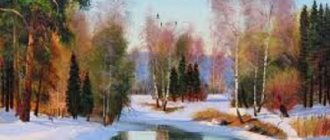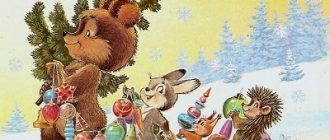Lesson notes for the middle group “what do we know about water?”
Lesson summary for the middle group
“WHAT DO WE KNOW ABOUT WATER?”
Educator.
Target.
Introduce children to the properties of water (taste, color, smell, fluidity).
Tasks:
v Clarify its meaning for all living things.
v Develop children's curiosity, thinking and speech; introduce the following words into the children's active dictionary: liquid, colorless, tasteless, transparent.
v Foster respect for water.
Methods and techniques:
Gaming (introduction of a game character, surprise moments).
Visual (diagrams, symbols).
Practical (experiments)
Verbal (conversations, teacher’s story, search questions).
Preliminary work:
Production of panels of symbols and diagrams.
Reading stories and fairy tales of an educational nature.
Conversations on the topic: “Where you can find water”, “Who lives in water”.
Materials and equipment:
Equipment for experiments: glasses of water (according to the number of children), empty glasses, salt, sugar, brilliant green, potassium permanganate, spoons.
Symbols indicating the properties of water
Emblems “When you wash your hands, don’t forget to close the tap tightly.”
Dunno doll.
Progress of the lesson
Children enter the group and sit on chairs.
Teacher (with the toy Dunno): Guys, today I went to kindergarten and met Dunno. He sat so sad. I asked him what happened, and he told me that it turns out he doesn’t know anything about water. I reassured him and the guys and said that we could help him. Shall we help? (Children's answers). Dunno, sit down on a chair. Our guys still know a little about water, but together, I’m sure we’ll figure it out.
Q: Guys, what is water? (Children's answers).
Water is a liquid. It flows. It can be poured into anything: a glass, a bucket, a vase. It can be poured out, poured from one vessel to another.
Experiment No. 1 “Water is a liquid.”
Would you guys like to try pouring water from one glass to another? (Children's answers). Go to the tables and sit comfortably.
Conclusion:
Water is a liquid; it can be poured or poured. And for you. Guys, you too, Dunno, better remember this, I prepared this symbol (posted on the board).
Experiment No. 2 “Colorless water.”
Q: Guys, what color do you think the water is? (Children's answers). We'll check this now.
On the teacher’s table is a white sheet of paper, a glass of milk, a glass of water.
Q: What color is the milk? (white). Can you say about water that it is white? (Children's answers).
Conclusion:
water has no color, it is colorless (a symbol of this property is hung in front of the children)
Experiment No. 3 “Water changes color.”
V.: Guys, I know that water can change its color. Want to make sure of this? What do you want, Dunno? (Answers).
On the teacher’s table there are 2 glasses of water, brilliant green, and potassium permanganate. This experiment is carried out only by the teacher.
V.: I’ll now add a magic crystal (potassium permanganate) to the water and we’ll see what happens to the water. Has the water changed its color? Now I’ll add a magic drop (green stuff) to the water. Let's see what happens to the water. Has the water changed its color? (Children's answers).
Conclusion:
water can change color depending on what is added to it.
Q: Do you think the water will change its color if you add jam to it? Try this at home.
Now, I suggest you guys taste the water. (Children are offered boiled water). What is she like? Sweet? Salty? Bitter?
Conclusion:
water has no taste, it is tasteless.
And so that you guys don’t forget this and you, Dunno, so that you don’t forget, I have prepared for you a symbol of this property of water.
Experience No. 4
(Children are given bowls with salt or sugar, spoons).
V.: Let's do a little experiment with you. Place the substance that is on your table in a glass of water (the teacher demonstrates). Stir and now taste the water. What did it taste like? (Children's answers). What do you think you added to the water? (Children's answers).
Conclusion:
It turns out that water can take on the taste of the substance that was added to it.
Experiment No. 5 “Water has no smell.”
V.: And now, I suggest you guys smell the water. Does the water smell anything?
Conclusion:
The water does not smell of anything, it has no odor.
A symbol of this property of water is displayed.
V.: You and I learned, children, that water can change color and taste. Can she change her smell? How do you think? (Answers). Try this experiment at home, and tell all the children what happens.
V.: And now I suggest you guys go to the chairs. Sit down too, Dunno.
Today, guys, we talk a lot about water, we learned a lot about it. But let's tell Dunno what water is needed for and who needs it?
V.: Well done, guys! Well, Dunno, did you learn anything new about water?
Dunno: Yes! It's just so hard to remember.
V.: And the guys, Dunno, will remind you again. Listen and remember: (based on symbols):
v Water is a liquid, it can be poured, poured, poured out.
v Water is colorless.
v Water is tasteless.
v Water has no odor.
Dunno: Well. Thank you, Dunno, now I know everything about water.
Q: Do you know, Dunno, that you need to save water, and when you wash your hands, you need to immediately turn off the tap?
Dunno: Why take care of it? Look how much water!
V.: There is a lot of water, but only purified water is needed for washing and cooking. And to get clean water, people spend a lot of effort. That’s why you need to save water and close the tap tightly.
And so that you, Dunno, don’t forget about this, here’s a reminder for you - a reminder: “When you wash your hands, close the tap tightly.”
Dunno: Thank you guys, now I will never forget that the tap must always be closed tightly.
V.: Guys, let’s hang the same reminders in our washroom. Do you agree? (Answers). And now I have another surprise for you (colored droplets are added). What do you think this is? (Answers)
I will give these drops to everyone so that you always remember that you need to take care of the water.
For the section methodical piggy bank.
Get text



